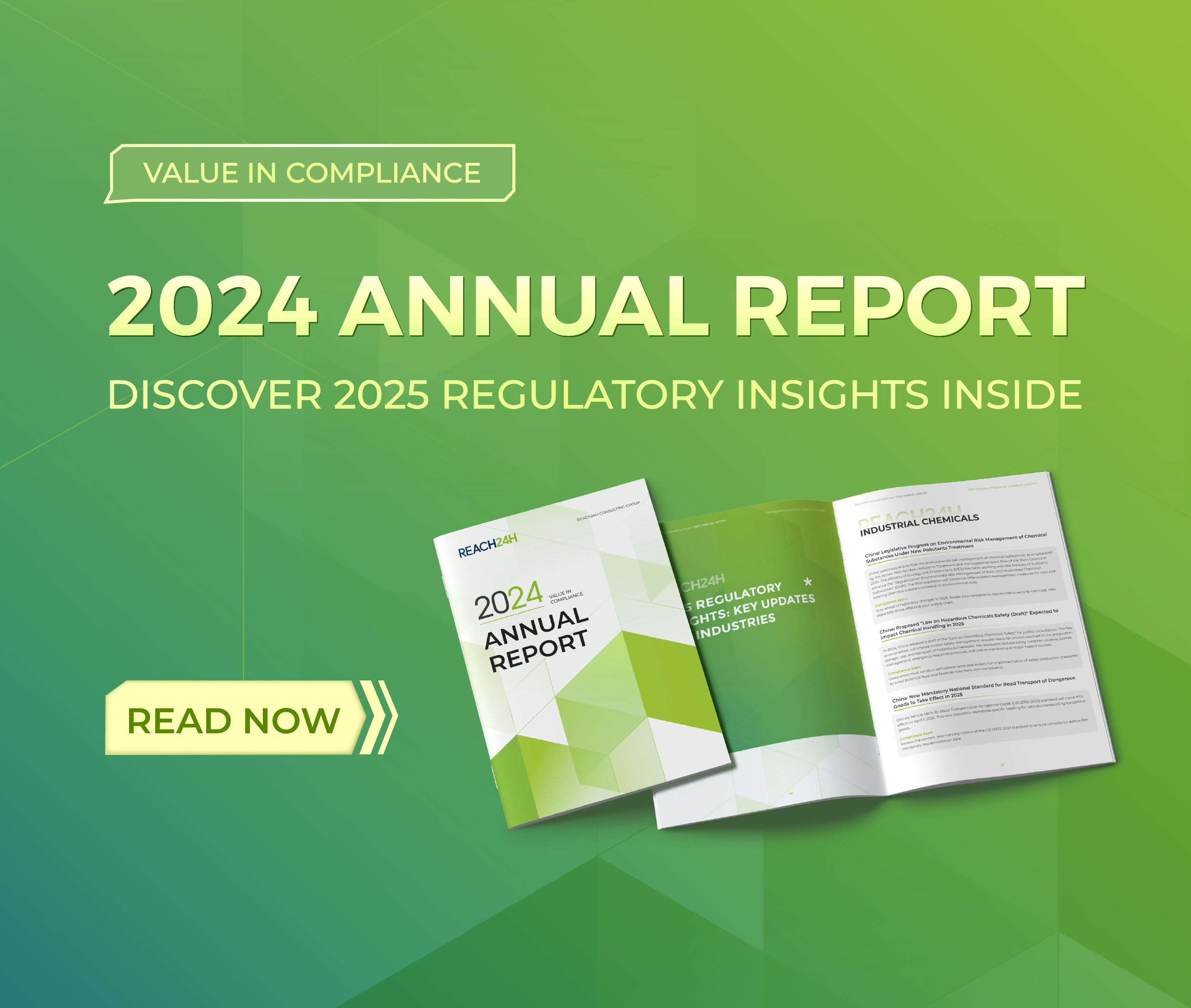Regulations on the Control over Safety of Hazardous Chemicals (China State Council [2011] Decree No. 591)
On 11 March 2011, the Chinese State Council issued the revised version of Regulations on the Control over Safety of Hazardous Chemicals (Decree No. 591). The regulation, which addresses the safe management of hazardous chemicals during their production, storage, use, operation (sales and import) and transport, will be put into effect on the 1st December 2011.
Background of Decree No. 591
The regulation was initially enacted in 1987 and has gone through two modifications, in 2002 and 2011. The earliest version has been expanded from 42 to 102 articles, combined with 4 supporting measures and a group of technical GB standards. Therefore the 2011 version is regarded as the most comprehensive law regulating existing chemicals in China. It is also the main legislation for implementing GHS in China. The following table demonstrates how the regulation has progressed over the two decades in respects of the applicable scope, definition of hazardous chemicals and the framework in general.
Table 1 – Evolvement of No. 591 Decree
|
Comparisons |
1987 |
2002 |
2011 |
|
Aim of the legislation |
For the purpose of: -strengthening safety management of hazardous chemicals; -guaranteeing safe production and the safety of people’s life and property; -protecting the environment. |
Deleted from the 1987 edition:
guaranteeing safe production |
New addition to the 1987 edition: -for the purpose of preventing and reducing hazardous chemical accidents; But no risk-related issues of hazardous chemicals are mentioned yet. |
|
Applicable Scope |
The production, storage, operation, transport and use of hazardous chemicals. |
New addition to the 1987 edition: the disposal of hazardous chemicals. |
The production, storage, use, operation and transport of hazardous chemicals. The five chains on the circulation link of hazardous chemicals are prioritized in a new order. The disposal part is deleted again from the 2002 edition and shall apply to other regulations regarding environmental protection. |
|
Definition of Hazardous |
Seven categories of dangerous chemicals were classified according to GB 6944-1986 (Classification and Code of Dangerous Goods): explosives, compressed gases and liquefied gases, flammable liquids, flammable solids, substances liable to spontaneous combustion and substances emitting flammable gasses when wetted, oxidizing substances and organic peroxides, poisons and corrosives. GB 6944-1986 was later replaced by GB 6944-2005. |
-hazardous chemicals listed in GB 12268-2005 (List of Dangerous Goods) -chemicals listed in the highly toxic chemicals inventory (about 150 chemicals); -other hazardous chemicals not listed in GB 12268 but identified and announced by relevant national departments (NETC, MPS, MEP, MOH, AQSIQ, MOT) GB 12268-2005 divides hazardous chemicals into 9 broader categories on the basis of GB 6944-2005 (Classification and Code of Dangerous Goods). |
Highly toxic and other chemicals that are toxic, corrosive, explosive, flammable, and combustion-additive etc. so as to cause damage to the human body, facilities and the environment. A new catalogue of hazardous chemicals is under way. The Catalogue of Hazardous Chemicals are compiled and published by the SAWS-led multi-departments (MIIT, MPS, MEP, MOH, AQSIQ, MOT, MOR, CAAC and MOA) and should be adjusted accordingly based on standards for the hazard identification and classification of chemicals. |
|
Drafting Department |
National Economic and Trade Committee (NETC) |
National Economic and Trade Committee (NETC) and State Administration of Work Safety (SAWS) |
The State Administration of Work Safety (SAWS) |
|
Table of Contents |
Chapter 1 General provisions (Article 1-6) Chapter 2 Production and use of hazardous chemicals (Article 7-21) Chapter 3 Storage of hazardous chemicals (Article 22-27) Chapter 4 Operation of hazardous chemicals (Article 28-31) Chapter 5 Transport and (un)loading of hazardous chemicals (Article 32-37) Chapter 6 Penalties (Article 38-39) Chapter 7 Supplementary provisions (Article 40-42) |
Chapter 1 General provisions (Article 1-6) Chapter 2 Production, Storage and Use (Article 7-26) Chapter 3 Operation (Article 27-34) Chapter 4 Transport (Article35-46) Chapter 5 Registration and Accidental Emergency Rescue (Article 47-54) Chapter 6 Legal Liabilities (Article 55-70) Chapter 7 Supplementary Provisions (Article 71-74) |
Chapter 1 General provisions (Article 1-10) Chapter 2 Production, Storage (Article 11-27) Chapter 3 Safe Use (Article 28-32) Chapter 4 Safe Operation (Article 33-42) Chapter 5 Safe Transport (Article 43-65) Chapter 6 Registration and accidental emergency rescue (Article 66-74) Chapter 7 Legal Liabilities (Article 75-96) Chapter 8 Supplementary Provisions (Article 76-102) |
|
Involved Departments and their Duties |
No definite duty division. Eight departments are mentioned in Article 10 and 42. |
Ten departments involved in the joint administration of hazardous chemicals as indicated in Article 5. The NETC takes major responsibility. |
Ten departments involved as indicated in Article 6: SAWS, MPS, AQSIQ, MEP, MOT, MOR, CAAC, MOH, SAIC, SPB. SAWS (instead of NETC) assume the major responsibility. |
Hazardous Chemicals Subject to the Regulation
The hazardous chemicals defined in the regulation refer to highly toxic and other chemicals that are toxic, corrosive, explosive, flammable and combustion-additive etc. so as to cause damage to the human body, facilities and the environment.
Stated in Article 3 of the decree, the Catalogue of Hazardous Chemicals (free download for 2002 English version now!) are compiled and published by the SAWS-led multi-departments (MIIT, MPS, MEP, MOH, AQSIQ, MOT, MOR, CAAC and MOA) and should be adjusted accordingly based on standards for the hazard identification and classification of chemicals.
During the second revision of the regulation, the first Catalog of Hazardous Chemicals was formulated in 2002. It contains more than 3,700 chemicals and a new catalogue that may include more than 7,000 hazardous chemicals is expected to be released by SAWS before 2012. Substances in the current hazardous chemicals catalogue (2002) are available on the inquiry page of hazardous chemicals (in Chinese only) under SAWS.
The 2002 catalogue consists of three parts:
1. hazardous chemicals listed in GB 12268-2005 (List of Dangerous Goods)
2. chemicals listed in the highly toxic chemicals inventory (about 150 chemicals);
3. other hazardous chemicals not listed in GB 12268-2005 but identified and announced by relevant national departments (NETC, MPS, MEP, MOH, AQSIQ, MOT)
In GB 12268-2005, hazardous chemicals are classified into 9 broader categories on the basis of GB 6944-2005 (Classification and Code of Dangerous Goods).
Hazardous Chemicals Regulatory Compliance
Companies who produce, store, use, sell or transport hazardous chemicals in China are subject to different obligations, for example, safety evaluation report, production license, safe use permit, operating license, registration of hazardous chemicals, SDS and chemical labels.
1) Registering hazardous chemicals at SAWS-NRCC: Manufacturers and importers of hazardous chemicals in China shall register identified hazardous chemicals with the National Registration Center of Chemicals (NRCC) of State Administration of Work Safety (SAWS) prior to manufacture or importation for the first time.
In order to better regulate the work of hazardous chemicals registration, the SAWS has recently issued the revised draft of Measures on Hazardous Substances Registration for public consult on October 11, 2011. The final Revised Measures are expected to be on public soon before the year’s end. Click for detailed interpretation on this revised draft in our news release SAWS Consults on Measures on HC Registration.
New! The revised draft of Measures on Hazardous Substances Registration is now available on REACH24H ebook store.
Notice: Apart from the SAWS issued measures for the registration of hazardous chemicals, the Chinese regulation on hazardous chemicals also involves another type of registration featuring the environment management of hazardous chemicals. Corresponding proposal has recently been drafted by China’s Ministry of Environmental Protection (MEP) for public consultation by 11 November 2011. Detailed information can be found in our news release on Draft Measures on Environmental Management of Hazardous Chemical Substances .
2) Preparing or updating China GHS-compliant classification and labeling and compiling the corresponding Material Safety Data Sheet (MSDS): According to the regulation, from 5 May 2011, all manufacturers and importers of hazardous chemicals in China shall supply the China GHS-compliant MSDSs and attach corresponding labels to the packing (including outer package) for the hazardous chemicals produced or imported. Detailed information can be found in our ebook Managing China GHS compliance and GHS Standards in China.
3) Applying for the Operation License: If your company is engaged in any commercial operation and marketing of hazardous chemicals in China, you should apply for the operation license to SAWS and other authorities.
4) Applying for the Production License: If you are a manufacturer engaged in the production of hazardous chemicals in China, you should apply for the production license.
5) Applying for the Safe Use Permit: If your company uses any hazardous chemicals to manufacture products (excluding manufacturers of hazardous chemicals), you should apply to the local SAWS authority at the city level for a safe use permit. Detailed information can be found in Measures on Hazardous Chemicals Safe Use Permit.
- Full text of Decree No. 591 is incorporated in our ebook, Managing China GHS Compliance, Annex IV Regulations on the Control over Safety of Hazardous Chemicals (Decree No. 591)
- For more detailed information on China hazardous chemicals (HC) regulations – please visit our Knowledge Base




